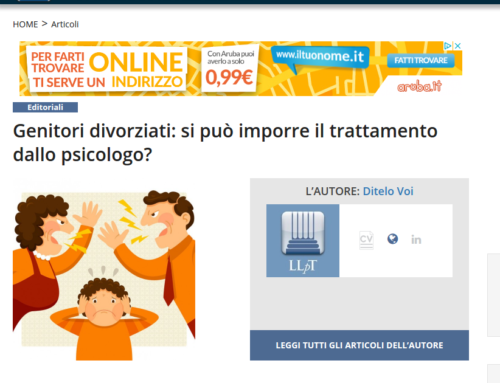Intervista al Dr. Craig Childress
A cura del Prof. Giovanni B. Camerini, Prof.ssa Tiziana Magro, Dott. Marco Pingitore
1. Would you describe your Model of Attachment-Based Parental Alienation?
The pathology traditionally called “parental alienation” is actually an expression of well-established and well-understood forms of existing personality disorder pathology, family systems pathology, and attachment trauma pathology. While the initial attachment-based description of this pathology may appear complex upon first encounter, it becomes increasing clear with familiarity. I will try to restrict my answer to this question to being as brief as possible, and for more detailed descriptions of the pathology I would refer you to my book, An Attachment-Based Model of Parental Alienation: Foundations, and to my online Masters Lecture Series seminars through California Southern University (search terms: Dr. Childress California Southern University).
At a superficial level of description, the pathology of “parental alienation” represents the addition of the “splitting” pathology of a narcissistic/borderline parent to a cross-generational coalition of this parent with the child against the other parent. The pathology of “splitting” is characteristic of both the narcissistic and borderline personality structure and is well described within the scientific literature on personality disorders, and is specifically defined by the American Psychiatric Association (2000). The triangulation of the child into the spousal conflict through the formation of a cross-generational coalition with one parent against the other parent is also a well-defined family systems construct described independently by the preeminent family systems theorists Jay Haley (1977) and Salvador Minuchin (1974).
The triangulation of the child into the spousal conflict through the formation of a cross-generational coalition with one parent against the other parent (called a “perverse triangle” by Haley) is always pathological. However, the addition of the splitting pathology of the narcissistic/borderline parent (i.e., a polarized perception of relationships into extremes of entirely-good or entirely-bad) transforms the already pathological family dynamic of a cross-generational coalition into a particularly malignant and virulent form that seeks to entirely terminate the other parent’s relationship with the child.
The splitting pathology of the narcissistic/borderline parent (as defined by the American Psychiatric Association) cannot accommodate to ambiguity. It polarizes perceptions of relationships into extremes of either all-good and idealized or as being entirely devalued and demonized. Within the splitting pathology of the narcissistic/borderline parent, when the spouse becomes an ex-spouse following the divorce, the ex-spouse must now also become an ex-parent as well because the neurological foundations of the splitting pathology cannot accommodate to ambiguous role relationships. In the mind of the narcissistic/borderline parent, the now “all-bad and demonized” ex-spouse also becomes an “all-bad and demonized ex-parent” in order to maintain the polarized consistency required by the splitting pathology of the narcissistic/borderline personality structure. The neurological structure of the splitting pathology prevents the narcissistic/borderline parent from perceptually registering the continuing attachment bond between the child and the now ex-spouse. For the narcissistic/borderline parent, the ex-husband must also become an ex-father; the ex-wife an ex-mother. There is no other alternative. This is a neurologically imposed imperative of the splitting pathology inherent to the narcissistic/borderline personality structure.
Making the ex-spouse an ex-parent is achieved by forming a cross-generational coalition with the child which against the other parent, and then inducing the child’s rejection of the other parent (the child is actually induced into adopting the “victimized child” role, which is then ultimately expanded into the child’s rejection of the other parent, and the process of inducing the child’s symptoms through the formation of a “role-reversal” relationship with the narcissistic/borderline parent requires a separate explanation). Through the child’s rejection of the other parent, the ex-husband becomes an ex-father, the ex-wife an ex-mother, consistent with the needs of the splitting pathology of the narcissistic/borderline parent.
At a deeper level of analysis, the pathology traditionally called “parental alienation” represents the trans-generational transmission of attachment trauma (disorganized attachment) from the childhood of the narcissistic/borderline parent to the current family relationships, mediated by the narcissistic and borderline personality traits of the parent (which are themselves the coalesced products of the childhood attachment trauma). This childhood attachment trauma of the narcissistic/borderline parent is embedded in the parent’s attachment system in the pattern of “abusive parent”/”victimized child”/”protective parent.” This process within the attachment system of pattern formation and repetition is called “internal working models” by Bowlby, who first described the nature of the attachment system, and these internalized patterns are referred to as “schemas” by Arron Beck, a preeminent expert in personality disorders and cognitive-behavioral therapy.
When the divorce occurs, the attachment system of the narcissistic/borderline parent activates in response to the loss of an attachment-mediated relationship with the spouse. The attachment system is the brain system that manages all aspects of close emotional love and bonding, such as children’s relationships with their parents, parents’ relationships with their children, and the spousal relationship of love and bonding. When the divorce occurs, the attachment system of the narcissistic/borderline parent activates to handle the loss of the attachment-mediated spousal relationship, and in activation of the attachment system, the internalized patterns of relationship expectations (the internal working models, or schemas) contained in the narcissistic/borderline parent’s attachment systems are also activated. However, for the narcissistic/borderline parent these underlying schemas are distorted by the childhood attachment trauma (that ultimately led to the distorted personality characteristics of the narcissistic/borderline personality), so that the response of this parent to the divorce and family dissolution becomes highly distorted by these internal working models of attachment.
The internal working models of relationship expectations contained in the attachment system of the narcissistic/borderline parent are in the pattern of “abusive parent”/”victimized child”/”protective parent,” which aligns with the current family members in the divorce of the ex-spouse, the current child, and the narcissistic/borderline parent. In the mind of the narcissistic/borderline parent, the ex-spouse becomes identified with the “abusive parent,” the child is identified as being the “victimized child,” and the narcissistic/borderline parent self-identifies with the role of the “protective parent.” The concurrent co-activation to two sets of representational networks, one for the current family members and one from the childhood attachment trauma creates a psychological fusion of these representational networks. In the mind of the narcissistic/borderline parent, the ex-spouse becomes the “abusive parent,” the child becomes a “victimized child,” and the narcissistic/borderline parent becomes the “protective parent.” The narcissistic/borderline parent then reenacts the attachment trauma from his or her own childhood into the current family relationships, with the ex-spouse assigned the trauma reenactment role as the “abusive parent,” the child is assigned the trauma reenactment role as the “victimized child,” and the narcissistic/borderline parent adopts, and then conspicuously displays for others, the coveted role as the all-wonderful “protective parent.”
However, this is all a false drama created from the childhood attachment trauma of the narcissistic/borderline parent being reenacted into current family relationships. None of it is true. The ex-spouse is not an abusive parent, the child is not a victimized child, and the narcissistic/borderline parent is not a protective parent. It is a delusion.
This delusional belief system is being enacted into the family processes by first inducing the child into accepted the “victimized child” role in the trauma reenactment narrative. Inducing the child into the “victimized child” role is accomplished by first eliciting from the child through directive and motivated parental questioning a criticism of the other parent. This elicited criticism from the child is then inflamed and distorted by the response it receives from the narcissistic/borderline parent into supposed evidence of the child’s supposed “victimization” from the allegedly “abusive” parenting practices of the other parent. Gradually, as this trauma reenactment narrative is co-constructed with the child, the narcissistic/borderline parent exploits and distorts the child’s authentic sadness surrounding the divorce into anger and resentment directed toward the other parent who is blamed for causing the divorce and break-up of the family.
Once the child surrenders into adopting the “victimized child” role in the trauma reenactment narrative, this automatically defines the targeted parent into the “abusive parent” role (irrespective of the actual parenting practices of this parent), and these two roles of “victimized child” and “abusive parent” allow the narcissistic/borderline parent to then adopt and conspicuously display to others the coveted role as the all-wonderful “protective parent.” All of this, however, is a false drama. It is a delusion. It represents the reenactment of childhood attachment trauma from the childhood of the narcissistic/borderline parent into the current family relationship, mediated by the distorting role-reversal relationship and communication processes of the narcissistic/borderline parent.
For more on this I would refer you to my book, Foundations.
2. Which are most frequent criticism to the model?
I have yet to hear any criticism of the model itself.
The only criticism, if one can call it that, is that there is no “peer reviewed” research to support it. But this is both an ignorant and spurious criticism involving a misapplication of a criticism of Gardnerian PAS to an attachment-based model for the pathology.
When Gardner proposed a “new syndrome” in mental health involving eight uniquely developed diagnostic indicators, he led the discussion down the wrong path. This pathology is NOT a “new syndrome” within mental health, it is a manifestation of already well-established and recognized forms of existing psychopathology (personality disorder pathology, family systems pathology, attachment trauma pathology). There is nothing “new” about this pathology.
The criticism levied against the Gardnerian PAS proposal of a “new syndrome” that was supposedly unique within all of mental health was that there was no scientifically established foundations for this “new and unique” form of pathology. And these critics were correct. This is the origin of the “no peer-reviewed research” and “no scientific foundation” lines of critique regarding the construct of “parental alienation.”
However, these lines of critique are not applicable to an attachment-based description of the pathology, because an attachment-based model is NOT proposing a “new syndrome” in mental health. An attachment-based description of the pathology is based entirely within well-established, well-recognized, and well-defined forms of existing pathologies (personality disorder pathology, family systems pathology, attachment trauma pathology). There is a substantial peer-reviewed literature regarding all of the pathologies involved in an attachment-based description of the family pathology traditionally called “parental alienation.”
The “peer-reviewed” line of critique is simply an automatic knee-jerk response of the allies of the pathogen to any effort to describe the pathology. It worked in derailing a Gardnerian PAS “new syndrome” proposal so they are bringing it out once again to attack an attachment-based model of the pathology in an effort to derail this description as well, yet without first comprehending the nature of the attachment-based model. When the “peer-reviewed” critique is brought up, this simply shows that the person levying this critique is not seriously engaged in the discussion but is simply promoting an agenda designed to hamper all efforts to address the family pathology created by a narcissistic/borderline personality parent surrounding divorce.
Personality disorder pathology has a substantial peer-reviewed and scientifically established foundation. Family systems pathology has a substantial peer-reviewed and scientifically established foundation. Attachment-trauma pathology has a substantial peer-reviewed and scientifically established foundation.
Critiques of an attachment-based model need to address the content of the model as described (briefly) in my answer to question 1, and as I more fully elaborate in my book, Foundations. So far, the only offered critiques of the content have been universally positive.
3. What about PA and DSM-5?
The pathology of attachment-based “parental alienation” can be consistently and reliably identified by the presence in the child’s symptom display of three characteristic and definitive diagnostic indicators that I describe in Foundations and in my other online seminars and writings. The diagnostic indicators for the pathology described by an attachment-based model of “parental alienation” are, 1) attachment system suppression, 2) narcissistic personality traits in the child’s symptom display (or phobic anxiety), and 3) a delusional belief in the supposedly “abusive” parenting practices of an actually normal-range and affectionally available parent. When these three diagnostic indicators of the pathology are present in the child’s symptom display, the appropriate DSM-5 diagnosis of the child’s pathology is:
DSM-5 Diagnosis
309.4 Adjustment Disorder with mixed disturbance of emotions and conduct
V61.20 Parent-Child Relational Problem
V61.29 Child Affected by Parental Relationship Distress
V995.51 Child Psychological Abuse, Confirmed
The diagnosis we are requiring be made – required under the professional’s “duty to protect” – is the final one on this list, V995.51 Child Psychological Abuse, Confirmed. This is the appropriate DSM-5 diagnosis for the pathology traditionally called “parental alienation.”
In order to acquire this DSM-5 diagnosis we first needed to define the pathology within established and existing forms of accepted pathology. Foundations accomplishes this. Based on the description of the pathology provided by Foundations, the pathology represents a DSM-5 diagnosis of V995.51 Child Psychological Abuse, Confirmed.
Pathogenic parenting practices by a narcissistic/borderline parent that are creating severe developmental pathology (diagnostic indicator 1), personality disorder pathology (diagnostic indicator 2), and psychotic (delusional) psychiatric pathology (diagnostic indicator 3) in a child, that is then resulting in the loss for the child of a healthy and normal-range affectionally bonded relationship with a normal-range and affectionally available parent, reasonably represents a DSM-5 diagnosis of V995.51 Child Psychological Abuse, Confirmed. If someone disagrees and proposes that it is somehow acceptable for a parent to create severe developmental, personality disorder, and delusionally psychotic psychopathology in a child through highly distorted and aberrant parenting practices, and that this is NOT child psychological abuse, I’m more than happy to engage that debate.
4. In your opinion, is PA a clinical phenomenal (like “stalking” or “mobbing”) or a syndrome? What do you not agree with about Gardner’s theory?
The pathology traditionally called “parental alienation” represents the trans-generational transmission of attachment trauma from the childhood of the narcissistic/borderline parent to the current family relationships, mediated by the personality disorder pathology of the parent. It is a clinical psychopathology involving three interrelated components, personality disorder pathology, family systems pathology, and attachment trauma pathology.
The pathology traditionally called “parental alienation” is NOT a “new syndrome.” It is a manifestation of well-established, well-defined, and fully accepted forms of existing psychopathology within mental health.
With regard to Gardner’s model of PAS, I do not agree with his proposal that this pathology represents a “new syndrome” that is unique within all of mental health. The pathology is NOT a new and unique syndrome, it is a manifestation of well-established, well-defined, and fully accepted forms of existing psychopathology within mental health (i.e., personality disorder pathology, family systems pathology, attachment trauma pathology).
I also do not agree with his eight anecdotal diagnostic indicators for the pathology. I believe they are poorly formulated and do not sufficiently differentiate the presence of the “parental alienation” pathology from other forms of parent-child conflict. I strongly advocate for a change to the three definitive and categorical diagnostic indicators of an attachment-based model for the pathology.
Regarding issues of “mobbing,” “stalking,” and “gaslighting,” in my view there is a variant of this pathology involving “malignant narcissism” (see Erich Fromm; The Heart of Man, 1964). We can discuss this variant more fully once we have solved the pathology of “parental alienation,” but I don’t want to distract from our current efforts to solve the core issue of “parental alienation.” Once establishment mental health recognizes the pathology and shifts to an attachment-based reformulation for defining the pathology, then a wealth of doors open in understanding attachment pathologies of increasing severity. I’m just waiting for people to catch up before revealing and opening these doors.
5. What is your proposal in AP cases with allegations of sexual abuses?
Sexual abuse allegations significantly complicate the issues surrounding the identification of the “parental alienation” pathology. This is not a question I can address in this format. However, let me make a few orienting comments;
1. Our goal is to protect 100% of children 100% of the time.
2. Authentic sexual abuse: When a child overcomes the shame and trauma of sexual abuse victimization and reports the existence of the sexual abuse, there is NOTHING more devastating for the child than not being believed. I am therefore extraordinarily reluctant to discount, under any circumstances, a child’s allegations of sexual abuse toward a parent.
3. I understand that this becomes a complicated issue, but I have worked with authentically sexually abused children in the foster care system and I know how difficult it is for a child to overcome the shame and family secret and to report sexual abuse by a parent. I am therefore extraordinarily reluctant to discount, under any circumstances, a child’s allegations of sexual abuse toward a parent.
4. The issues surrounding this have to do with decision-making criteria and the risk of making Type I and Type II errors. It also includes issues of what’s called the “low base-rate phenomenon” and its impact relative to making Type I and Type II errors. I have a preparatory essay on this issue on my blog, False Allegations of Abuse: Technical Issues.
5. In my analysis of the pathogen (i.e., the characteristic patterns of distortion to the information-structures of the attachment system) that creates attachment-based “parental alienation,” it is a trauma pathology that is transmitted trans-generationally through the attachment system. The nature of this “parental alienation” trauma pathogen has a number of characteristic features of sexual abuse trauma, particularly incest, which leads me to suspect that the initial trauma that entered the family system a generation or two prior to the current enactment of the “parental alienation” pathology was sexual abuse of a child, possibly incest, either of the current allied parent or possibly the grandparent of the current child, and it is this relationship-based trauma that is being transmitted trans-generationally to the current family relationship pathology. If I am correct, then the pathology of attachment-based “parental alienation” represents a second or third generational iteration of sexual abuse (incest) trauma. This would mean that the pathology of attachment-based “parental alienation” is a variant of sexual-abuse trauma being expressed across generational iterations.
6. Since the pathology of attachment-based “parental alienation” involves a delusional trauma reenactment narrative, careful consideration of the issues regarding sexual abuse allegations is warranted.
7. This issue merits sober professional dialogue and discussion.
8. The goal is to protect 100% of children 100% of the time from all forms of child abuse.
Iscriviti alla Newsletter: ricevi aggiornamenti via e-mail e/o via WhatsApp
Condividi questo post
One Comment
Leave A Comment
You must be logged in to post a comment.










[…] Marco. “Parental Alienation, Interview with Craig Childress”. Italian Society of Forensic Science. Retrieved 3 […]